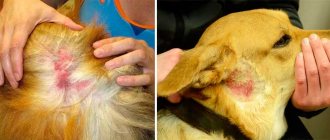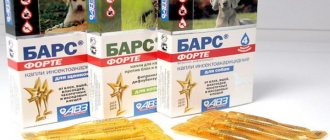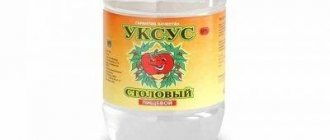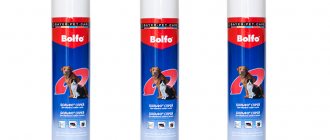The dangerous time will soon begin, and in the summer ticks will turn into a real scourge. It is difficult to pull an insect out from under the skin, but this is not enough. After all, they are carriers of many diseases. Therefore, it is better not to wait for their bites, but to protect yourself from attacks in advance with the help of tick repellents.
In this article we will look primarily at folk remedies. For those who have little time, we can suggest simply buying ready-made tick repellents, such as Gardex, Kleschevit, Medilis and other repellers.
Method number 4. Anti-tick spray
Sprays are very popular among owners of large breed dogs.
The bottle allows you to spray the drug over the entire body of the dog, providing complete protection to the tail, belly, hind legs, croup and, of course, the front area. This method should be used by owners whose pets spend a lot of time outdoors (hunting, watchdog or service animals). You can't protect an animal better than a spray can. There should not be any difficulties with use, but there are still some features. Spray the product outdoors, lifting the fur each time. Do not go home until the fur is dry. Negative characteristics include the toxicity of the composition and high pricing. Before spraying, cover your airways and your pet's nose and mouth. Before direct application, study the manufacturer’s recommendations. Pay special attention to the sections “Contraindications” and “Application”. Typically, these areas have a long list of activities.
Protection for children
Folk remedies for protecting children from ticks should be gentle, non-irritating to the skin, and without strong odors, so they do not use alcohol, vinegar or colognes.
The following aromas are pleasant to humans, but repellent to blood-sucking insects, on the basis of which children's tick repellent products are made:
- tea tree essential oil;
- geranium essential oil;
- sweet almond oil;
- culinary cloves;
- vanillin.
Before preparing protective equipment, make sure that the child has no allergies or individual intolerance to the components used.
Tea tree oil spray
To make it you will need:
- tea tree essential oil – 10-15 drops;
- water – 50 ml.
Preparation and use:
- Mix the ingredients in a bottle with a sealable lid.
- This mixture separates. Be sure to shake it well before each use.
- To use, moisten a cotton swab or palms with the solution and wipe the exposed areas of the child’s skin and hair. You can additionally spray your clothes with the solution.
Tea tree oil soap
To make it you will need:
- tea tree essential oil – 10-15 drops,
- soybean oil – 5-10 ml;
- shower gel/liquid soap – 30 ml.
Preparation and use:
- Mix soybean oil and detergent (gel or liquid soap) in a container.
- Add essential oil, mix thoroughly.
- Use as a cleanser when showering before and after walking outdoors.
Almond oil
To make it you need:
- almond oil – 2 tbsp. spoons;
- geranium essential oil – 15-20 drops.
Preparation and use:
- Mix almond oil and geranium essential oil until smooth.
- Pour the mixture into a dark container. In this form, the product is stored for up to 6 months and used as needed.
- Rub a few drops of the mixture onto exposed skin.
Clove infusion
To make it you will need:
- cloves (culinary) – 1 tsp. spoon;
- water – 200 ml.
Preparation and use:
- Mix cloves with water, put on fire and bring to a boil.
- Let the broth brew for at least 8 hours.
- Moisten a cotton swab with a decoction of cloves and treat exposed areas of the body before going out into the open.
"Sweet water"
For production you need:
- vanillin – 2 g;
- water – 1 l.
Preparation and use:
- Mix vanillin with water, put on fire and bring to a boil.
- Allow the solution to cool.
- Moisten a cotton swab with the decoction and treat exposed areas of the body to repel insects.
Traditional methods of protection against ticks do not last long, so they require re-application every 1.5-2 hours, and do not provide 100% protection. Be careful when walking with children.
Recipes
There are a number of remedies that can be prepared at home. All of them have a repellent, rather than killing, tick effect. It should be remembered that traditional methods cannot protect a dog from parasites one hundred percent, so after walks you need to examine your pet for bites. Most ticks stick to the neck, ears and other places where the dog cannot scratch them off.
During the inspection, special attention is paid to these areas. If the fur is thick, it is advisable to also comb your pet.
Owners of dogs with thick hair often notice a tick only after a bite, when it increases in size
Treatment by any means must be carried out immediately before leaving the house. If the dog is outside all day (at the dacha, on a hike, on a hunt), you need to apply the product every 2-3 hours.
Essential oils
Due to the pungent odor, which creates the anti-tick effect, products based on essential oils can be unpleasant for dogs and interfere with their sense of smell. You need to carefully monitor your pet’s reaction; if there are negative symptoms or deterioration in health, you should stop using the product and try another one. For pregnant women and puppies, it is better to use tea tree.
Aroma oils that repel ticks:
- tea tree;
- carnation;
- lavender;
- eucalyptus;
- geranium;
- palmarosa;
- bay oil;
- Cedar oil;
- mint;
- rosemary;
- thyme;
- basil.
It is not advisable to apply pure essential oils to the fur so that the dog does not lick them off. You can drip oil onto the withers. Another application:
- Mix essential oil, water and alcohol (in a ratio of 1:10:1).
- Spray the mixture on the pet's withers, sides, and belly.
Scented collars are commonly used to protect ticks:
- To aromatize, apply 15–20 drops of essential oil to the collar.
- You can make a mixture of geranium and sweet almond oils, which additionally repels ticks due to its sulfur content (15-20 drops of geranium per 2 tablespoons of almonds). This product is stored in an opaque container in the refrigerator for six months and applied to the collar as needed.
Vanillin
This product is completely harmless. However, only pure vanillin works; vanilla sugar will not work because it has a very weak odor. Vanillin can be used for animals of any age. The exception is alcohol tincture; it should not be used on small puppies.
Vanillin with vodka:
- Mix 100 ml of vodka (or alcohol 40) and 2 grams of vanillin.
- Place in a cool place.
- Leave for a week.
- Apply to the dog's withers, belly and legs.
You can use an aqueous solution of vanillin:
- Dissolve 1-2 packets of vanillin in a glass of warm water.
- Stir until vanillin is completely dissolved.
- Spray the dog with the mixture.
You can also simply sprinkle your pet with vanilla liberally from head to tail. It needs to be rubbed in thoroughly, especially where the fur is thick.
Sagebrush
This plant repels ticks and fleas.
- Take 50 grams of fresh wormwood or 20 grams of dried wormwood.
- Pour half a liter of water over the grass.
- Bring the mixture to a boil.
- After cooling, pour the broth into a spray bottle and spray the dog.
Tar
The tar smell is intolerable to ticks and fleas. Unfortunately, it is also unpleasant for most people, which is why in the city the most effective option for using tar—smearing it on a dog—is of little use. However, when hunting or hiking, this product can help.
Tar helps not only protect against forest ticks, but also get rid of ear parasites in dogs
In the city, anti-mite “perfumes” can be made using tar soap in combination with essential oils:
- Take a glass of water, tar soap and essential oils:
- grapefruit;
- thyme;
- oregano;
- juniper;
- myrrh.
- Grate the soap.
- Mix with water.
- Add 2 drops of each essential oil to the mixture.
- Spray the animal with the resulting mixture.
You can also bathe your dog before a walk with tar soap; in addition, it is advisable to rinse it with a decoction of wormwood. This is not a very convenient method, since bathing is a long process. But the smell that repels ticks will last a little longer.
Garlic
Ticks do not like the strong smell of garlic. It must be remembered that garlic is toxic for dogs and can cause poisoning, so a product based on it should be carried to places inaccessible for licking.
Garlic tincture:
- Take 2-3 cloves of garlic.
- Grate or grind in a mortar or garlic grinder.
- Pour three glasses of water.
- Leave for at least 8 hours.
- Apply the tincture to the dog’s head and withers.
How to get rid of unwanted pets
A dog-repellent scent can be used against uninvited guests who wander onto your property, lawn or flowerbed. You need to know how to discourage dogs so that they don’t come back, but also not harm them. It is better to use natural repellents - lavender, vinegar, garlic, alcohol. You can turn on the ultrasonic repeller once. If dogs are aggressive, it is better to spray an aerosol.
Dog repellers have an unpleasant odor
A dog's sense of smell is famous for its keenness. The dog is able to distinguish all kinds of aromas. Unpleasant odors irritate the animal and cause it stress, so such “stinkers” should be used only as a last resort.
Effective store-bought drugs
Today there is a variety of effective store-bought products. To prevent poisoning of the animal and deterioration of its health, you should choose trusted stores, veterinary pharmacies, and websites. Safe and effective drugs are discussed below.
Drops, solutions, sprays and tablets
The most popular means are drops. They are applied to the withers of the animal. The dog's coat should be dry. Active ingredients applied to the skin repel blood-sucking fleas and destroy existing fleas. The drops are valid for 3 weeks. The greatest effectiveness is observed in the first week.
In order not to harm the dog’s health, it should be weighed and based on its mass, calculate the required number of drops. If you exceed the amount specified in the instructions, side effects may occur, but a smaller amount will not lead to the desired result.
The drug is applied to the skin. If the pet is large, then the composition can be distributed along the ridge
It is important that the animal does not reach the treated area with its tongue.
The most popular means include:
- "Frontline", which is widely used as a remedy for ear mites;
- "Advantix", which protects against various types of insects;
- “Practician”, also used to treat parasitic dermatitis.
A new development is tablets that eliminate all known types of parasites. These drugs act instantly. Already 3 hours after administration, the active ingredients are detected in the circulatory system. All existing fleas and ticks die immediately.
The active substance, penetrating the animal’s body, dissolves in the stomach. It then enters the circulatory system, after which the metabolites are excreted through the kidneys. Bloodsuckers who bite such a dog have their nerve cells blocked, which causes the death of the parasites.
To protect your pet for several months, a single dose of the drug is required. The dosage calculation depends on the type of tablet. Typically, treatment requires 25 to 50 mg of the drug per 1 kg of pet’s weight.
The following tablets are known on the Russian market:
- "Frontline";
- "Bravecto";
- "Credelio."
A water-based spray consists of active drugs and ingredients that help the solution to be better absorbed into the skin without forming a greasy film. First of all, the components are applied to the withers, then the legs, tail, chest, and belly are treated. A small amount of solution is rubbed near the eyes and ears. The maximum dosage per 1 kg of body weight is 6 ml of spray. For long-haired dogs, the calculation is based on the maximum allowable dose.
The most common sprays are:
- "Foline";
- "Fiprex".
Collars
Collars are considered the most effective method of combating surface ticks. But they are not always able to cope with subcutaneous types of parasites. In addition, the protection of such products against ticks is shorter than against other types of insects. This fact must be taken into account to ensure timely protection of the pet.
Flea collars are made of flexible plastic tape treated with special components. The active substances are released dropwise, thus saturating the pet’s fur. When using tape, the pet's tail area and belly remain vulnerable. Some animals may experience an allergic reaction in the form of redness and itching.
The most popular collars in Russia include:
- "Kiltyx." Its validity period is 6 months.
- Foresto remains active for 8 months.
Specialized shampoos
Blood-sucking shampoos have a short shelf life. They are usually used before a short stay in the fresh air. It is possible to use shampoo if you are going to walk in a dangerous area, and the drops are running out of time.
Washing with a specialized solution is also advisable for washing away the fatty film with accumulated parasites. After bathing, as the fur dries, you should comb out dead parasites.
This product is also used as an auxiliary.
The most popular shampoos are:
- "Dana";
- "Leopard";
- "Lugovoy".
Experienced dog breeders use combinations for protection against ticks in the form of drops, a collar, and shampoo.
How to protect a pregnant and lactating bitch from parasites
It is highly undesirable to treat a female dog for fleas during pregnancy. The owner must take this into account and be sure to carry out the treatment earlier. If you cannot do without it after pregnancy, consult your doctor. He will tell you which flea and tick treatment is best for your dog.
Manufacturers of Bravecto, Simparica, Nesgard allow pills to be given during pregnancy. But we must remember that at this time, especially at the beginning of pregnancy, the baby’s organs are formed. Any tablets can affect this process, so it is better to use drops against fleas and ticks.
As for lactation, flea and tick tablets can get into the milk and cause a negative reaction in puppies. Manufacturers do not indicate this, but many drugs have this effect on infants. Therefore, to protect the bitch, it is better to use anti-tick drops, applied to the withers, between the shoulder blades. It is imperative to ensure that the puppies do not lick the flea and tick medication when the bitch is lying down.
Types of ticks that pose a danger to dogs
The expression “Everyone does their job” also applies to ticks; some attack from the outside, others penetrate the skin, and others coexist with the animal all its life. All ticks are carnivorous parasites that have a similar structure - a round body, 8 legs, a head “equipped” with a proboscis. Parasites have a “branchy” tree of families; without going into details, the following types of mites are distinguished:
Intradermal - live on the body of a healthy animal and parasitize when the immune defense drops. Demodicosis is a skin disease caused by intradermal mites. Accompanied by hair loss, changes in the skin, itching, and if left untreated, leads to death.
Subcutaneous - transmitted by contact, live in the upper, less often, deep layers of the skin. They cause severe itching, inflammation, hair loss, and the development of secondary pathologies. Subcutaneous mites cause a number of diseases - sarcoptic mange (scabies), otodectosis (ear scabies), cheyletiellosis (stray dandruff).
Ixodids (forest) are parasites that attack from the outside, when walking in nature. Ticks stick to the dog's skin for the purpose of saturation. They are carriers of a number of serious, sometimes fatal or dangerous diseases for humans. The virus is transmitted through a bite, or more precisely, through the saliva of the parasite.
Basic care after removing ticks from dogs
If you see ticks on your dog's body, remember that you can also try to remove them yourself using special tweezers that you can get from your veterinarian. To remove ticks from a dog , it is recommended to use gloves to prevent them from sticking to your skin, as it can also bite you and cause a number of diseases such as turalemia.
When we manage to remove the tick, whether we did it with tweezers or previous home remedies, we must disinfect the area with iodine to heal any wound that this insect may have caused to the dog.
How dangerous are ixodid ticks?
Hundreds of articles, scientific papers and studies have been written about the dangers and mortal danger of ixodid ticks. Nevertheless, many owners ignore basic things, hoping for a miracle. There is definitely little hope to protect a dog from ticks; these universal parasites pose too serious a threat.
In addition to a relatively harmless purulent abscess at the site of the bite, the tick is a carrier of a number of dangerous diseases:
Bartonellosis is dangerous for dogs, and sometimes for people. It can occur in a latent form and end in sudden death, but is detected by an ROC blood test for the presence of viruses. A dog whose immune system contains the virus can remain a carrier for several years. In the open form, the following are observed: inflammation of the joints, fever, anemia, weakness in the hind limbs, weight loss, drowsiness, abnormalities in the heart, smoking, hemorrhages in the eyeballs or nosebleeds. In the acute form, pulmonary edema and meningitis develop.
Hepatozoonosis - the disease is diagnosed quite rarely, however, it is found everywhere. If infected, the probability of death is more than 80%. The virus is difficult to detect even in laboratory tests. Most dogs remain “healthy” carriers after being bitten, but when the body’s immune defenses are reduced, the virus begins to attack. Given that symptoms appear suddenly, the disease is often confused with bartonellosis and piroplasmosis. A sick dog has: an unsteady gait, weakness of the hind legs, inflammation of the joints, muscle pain, anemia, rarely, diarrhea with a significant admixture of blood. In the later stages, myositis develops - inflammatory processes of the bone apparatus.
Piroplasmosis (babesiosis) is the most common disease affecting dogs due to a tick bite. It is not dangerous for humans, but the risk of infection for dogs is more than 90%. The disease is accompanied by massive destruction of red blood cells, which leads to a drop in hemoglobin levels, kidney failure, and oxygen starvation. In terms of infection, “voracious” females are more dangerous; after drinking blood, the tick injects “waste” into the dog’s body – plasma infected with the virus. Piroplasmosis is accompanied by an incubation period of 2–14 days (rarely up to 20), after which symptoms appear: lethargy, refusal to eat, pale mucous membranes, wobbling gait, jaundice, difficulty breathing, gastrointestinal upset. A symptom that allows you to visually diagnose piroplasmosis with an 80% probability is a change in the color of urine to brown, reddish, gray-green.
Ehrlichiosis is a rarely diagnosed disease, the reason is the difficulty of identifying the pathogen. Most often, the disease occurs in parallel with piroplasmosis (one tick carries 2 viruses), which significantly complicates treatment. The disease proceeds unnoticed for 2–20 days, after the end of the incubation period the following symptoms appear: changes in baseline body temperature from normal to 41°, sudden weight loss, difficulty breathing, noticeable enlargement of lymph nodes, purulent discharge from the nose and eyes, convulsions, paralysis. In the acute stage, a tendency to causeless bleeding develops. If the diagnosis of the acute form is reduced to blood tests without ROC samples, the results are false negative.
Lyme disease (tick-borne borreliosis) is a dangerous disease for dogs and people. The acute form rarely appears; after 3–12 days, the dog shows the following signs: increased temperature or temperature fluctuations, stiffness of movements, inflammation of the joints in the area of the bite, enlarged lymph nodes, problems with the heart and breathing, apathy, loss of appetite. The chronic form is accompanied by arthritis, causeless inflammation of internal organs, and destruction of blood vessels. The virus is transmitted in utero, which most often kills offspring in the early stages.
How to identify a tick
Ticks are a type of ectoparasitic mite, that is, parasites that settle in the bodies of other living creatures to feed on their blood. Typically, when these parasites jump on our dog to establish themselves as guests, they are small in size, which increases in size as they feed on our dog's blood. It is ideal to identify them when they are small , as they are much easier to eliminate with home remedies. But if we see them when they are already large, we will have to remove them ourselves using tweezers.
To know how to identify a tick in our dog, we must remember that the time of year in which they are most active is from spring to autumn . Therefore, if we are within this period of time, we should check our dog's coat daily. Ticks usually live in areas with tall grasses or bushes, so if we walk our dog through parks or forests with this type of vegetation. We must take care of the body when we get home as it is likely that they have become infected with ticks.
It is very important to remove ticks from your dog quickly because they carry diseases such as Lyme disease , a common disease in dogs that can lead to illnesses like:
- Inflamed joints
- Changes in your dog's skin
- The appearance of fever and malaise in a dog
- Muscle pain
However, if ticks are still small in size, how can we identify them? Very simply, paying attention to the main symptoms:
- The dog scratches more than usual in areas such as the neck or ears.
- Light bleeding on the skin, which may be associated with a small rash, swollen area, or redness.
Preventive actions
A number of measures will help protect your dog from tick bites.
To avoid your pet being attacked by bloodsuckers, try:
- Do not walk it in places with dense vegetation or damp areas.
- Use pharmaceutical preparations that are applied to the withers in such a way that the animal cannot lick them off.
- Use a parasite collar.
- Wash the animal with a specialized shampoo that will destroy existing bloodsuckers.
- Treat your dog with a spray if he rarely walks outside, but he will be traveling to a place with dense vegetation.
- Do not combine different types of drugs to prevent poisoning of the animal. The majority of specialized products contain pesticides.
- Monitor your pet’s condition on the first day after applying the solution for a timely reaction in case of signs of poisoning.
Ticks are carriers of many diseases. To prevent infection in pets, veterinary pharmacies offer a wide range of drugs, among which it is not difficult to find one that is suitable specifically for your four-legged friend.
Other dog repellents
Unfortunately, sometimes you have to use a dog repellent. These products have an unpleasant odor for animals. Feeling a nasty aroma, animals stop going to someone else’s garden and running onto the lawns. It is important to choose the right non-toxic repeller.
Types of repellers
People who are trying to find something to scare dogs away know that there are several types of means:
- aerosol - sprays with an unpleasant odor;
- electric - stun guns;
- ultrasonic - emit ultrasound that is unpleasant for dogs.
A repeller can be used if a pet shows an unhealthy interest in something forbidden, for example, picking up something from the ground. Aromatic products are sometimes carried by people jogging or cycling.
Criterias of choice
It is recommended to use aerosol or ultrasonic repellers, as these are the safest means. Pepper spray should not be used on dogs.
Note! It is best to buy the drug “Antidog” and similar products. It won't cost much, but it will be effective.
Recipes
There are many traditional methods to protect your pet from parasites. The vast majority of them are based on the principle of treating the animal with parasite-repellent compounds that help protect both the four-legged friend and humans in the forest or field.
Essential oils
The most ancient and frequently used substances for protection are various essential oils, whose strong smell most insects cannot stand. This is a completely natural and safe product. Ticks can't stand the smell:
- Tea tree.
- Eucalyptus.
- Carnation.
- Thyme.
- Thyme.
- Basil.
- Rosemary.
- Cypress.
There are several ways to use it:
- Mix a few drops of different oils with a tablespoon of vodka, soak a cotton swab and attach to the comb. Once a week, carefully comb the animal's fur, but be careful with the muzzle, the strong smell can harm the sense of smell.
- Add 20 drops to 200 ml of shampoo and use when washing.
- Every day before a walk, soak your collar in a mixture of essential and sunflower oils.
Infusions
Infusions have proven themselves to be an excellent insect repellent while walking. Their only drawback is daily treatment before each walk. Dog breeders know the most effective mixtures:
- Garlic. For 0.5 liters of water, take 2-3 cloves of garlic, chop it, add to the liquid and leave to infuse for 8 hours. Right before a walk, treat the withers and back so that the dog cannot lick the liquid.
- Vanilla. Add 2-3 grams of vanillin or vanilla to 100 ml of vodka. The mixture is infused in a dark place for 10 days, then it is ready for use. The liquid is not sprayed, but applied directly to the skin on the withers, stomach, back and legs.
- A decoction of wormwood helps protect against any insects; the strong specific smell effectively repels arthropods. Add 20 grams of crushed dry herb to water and boil, let cool, strain and pour into a spray bottle. This spray can be used not only on the dog’s fur, but also on bedding, toys and the kennel.
Folk remedies for ticks
Not every owner dares to use anti-tick chemicals for their dog. Their use is very simple, you can find them in almost any veterinary pharmacy, and they are inexpensive. But an animal can lick a part of the body treated with the drug, scratch it with its paw, and then lick this paw.
This may not cause serious health problems, but getting poison into the stomach is not good in any case. In addition, a dog treated with a chemical preparation should not be allowed near children for some time.
Therefore, owners often turn to folk remedies for protection against ticks for dogs. Some of the most easily accessible and easy to use are the following:
- Aroma oils. The smell of tea tree oil, mint, cloves, lavender, eucalyptus, and lemon repel ticks. But you cannot drip concentrated oil directly onto the wool; it must be mixed with water and alcohol (take 1 part oil and alcohol to 10 parts water). The resulting solution is sprayed onto the dog’s neck, sides, and belly. Avoid contact with the face. You can drop a drop of oil on a collar made of felt or nylon. But the smell of concentrated oil can bother the animal, so you need to monitor its reaction.
- If the dog lives and walks in the courtyard of a private house, then pink geranium or marigolds should be planted on the site. The smells of these plants repel ticks; they simply will not approach such an area. You can rub the pet’s fur with the broken leaves of these plants if you plan to walk outside your own area.
- Tar soap is a common treatment for ticks. The dog is washed with soap. But you need to remember that the smell will be quite unpleasant.
- Wormwood decoction - rinse the dog with it after washing. Can be used in combination with tar soap. The smell of such a mixture can bother the dog, so you need to monitor your pet after washing.
There are also more complex compositions of folk remedies for ticks for dogs:
- A mixture that can be stored in the refrigerator for a long time (up to six months): sweet almond oil (2 tablespoons), 20 drops of geranium oil. Almond oil contains sulfur, which repels ticks, as does the scent of geranium. Before a walk, the mixture should be applied to the animal’s fur and collar.
- The mixture, which is used as a spray (pour into a spray bottle and spray the dog): take 2 drops of 6 types of oils (juniper, grapefruit, rosewood, thyme, myrrh, oregano) and a third of a teaspoon of tar soap, rubbed onto a glass of distilled water. grater
If the dog is outside all day, then oils and sprays should be used several times a day (3-4). After a walk, the pet needs to be carefully examined; protecting a dog from ticks using folk remedies is not 100% effective. There remains a small chance of tick bite. The dog needs to be examined; if a tick is found, it must be properly removed and a veterinarian should be consulted.
Popular types of anti-tick drugs
- Carbamates. Most often, collars are impregnated with them. Among the most popular are Bolfo, Bansect, Kiltix, Zodiac collars. Carbamates begin to act immediately after a tick hits the fur. They block his nervous system, disrupting the feeding process, which leads to death. Carbamates are effective not only against ticks, they will also help protect your dog from fleas. The downside of these products is that the parasite quickly gets used to the active ingredients.
- Amidines. They also block nerve impulses in ticks and also repel them. Unlike carbamates, amidines are not addictive. Their disadvantage is that they cannot be used in puppies and small breeds. Amidines are the main substance in Promeris drops and Preventic collar.
- Pyrethroids. They have a paralytic effect on ticks, but are safe for dogs. The advantage of this substance is its ability to accumulate in the sebaceous glands, providing a prolonged effect. At the same time, pyrethroids are quite allergic. They are the basis of drops Bars, Zodiac+, VetCare, UltraGuard, Celandine, collars Scalibor, Mr. Bruno, Bars, Dana.
- Phenylpyrazoles. They only affect the pest. Among all anti-tick drugs they have the lowest toxicity for the animal. With their help, you can protect your dog from almost all types of ticks, as well as fleas and lice-eaters. Upon contact with phenylpyrazoles, arthropods quickly lose energy and die due to chaotic fast movements. The composition of the products includes two types of phenylpyrazoles - fipronil and pyriprole (waterproof). These are Frontline, Mr.Bruno+, Effitix drops; spray BlochNet+, Fiprist; drops, spray and collar Bars Forte.
- Isoxazolines are included in anti-tick tablets. Can be used for all breeds. They are quickly absorbed into the blood and affect the pest after the bite. Effectively fight against X-ticks and fleas.
Attention! To achieve maximum effect, combine products with different compositions, while avoiding an overdose of one active ingredient. This will prevent arthropods from developing immunity to the drug.
You can now see the current price of anti-tick products for dogs and buy them right here from Yandex Market with fast delivery:
Dog protection against ticks
There are two dangerous periods during which ticks begin their breeding season. They need increased nutrition, which is blood. It is necessary to use protective equipment in early spring, from the snow melting until the grass cover is fully formed. Ticks are also dangerous in late autumn, during the period preceding the first frost. Manufacturers of animal products offer a wide range of products to combat these insects. Can be used for protection:
- collar,
- drops,
- shampoo,
- spray,
- pills,
- powder
The products differ in their methods of application, mechanism of action, and effectiveness. When choosing, the individual characteristics of the pet and the specifics of keeping the dog are taken into account. Each drug is accompanied by instructions, the recommendations of which must be strictly followed. The products contain toxic components necessary to repel and destroy insects
It is important to exclude the possibility of them entering the dog’s body. Correct use of drugs guarantees high efficiency and safety
The most effective essential oils against ticks
The following oils have the highest repellent properties and are least toxic to humans:
- eucalyptus;
- carnations;
- anise;
- lemon;
- mint;
- pine trees;
- fir;
- rosemary;
- thyme.
When choosing a product for making a natural repellent, you must first focus on its properties, availability, and also take into account who the composition will be used for.
Insect Collar
The best option for a dog that is regularly exposed to danger is a special collar. This accessory will prevent ticks from attacking in the most unprotected area. Insects are often localized on the pet's neck, since this area is inaccessible to the dog. Collars are made of polyvinyl chloride. They are impregnated with chemicals and plant compounds. Strong odors repel not only ticks, but also fleas and mosquitoes. These accessories have several advantages. They:
- do not come into contact with skin, eliminating the risk of allergies;
- do not cause discomfort to the dog;
- convenient to use.
The collar is placed on dry hair, which does not allow chemicals to reach the skin. If the dog has been walking in the rain, it needs to be bathed, the accessory is removed, then put on again, the effectiveness of the protection is maintained. The activity of the impregnation components can last up to six months. Collars are available in a wide range; you can choose a comfortable product for a dog of any breed. As a last resort, it can be trimmed to give the desired parameters. It should be noted that this device should fit snugly enough to the neck, but it is not advisable to wear it under a regular leather collar. In this case, the active ingredients will be absorbed into the material of the accessory. This method of protection is not used for pregnant, lactating bitches, or sick dogs. The most popular products among dog breeders are: Kiltix, Beafar, Scalibor, Hartz, Doctor Zoo.
How to protect your dog from fleas
A flea can jump on a dog even if the pet has not been in contact with other dogs. Therefore, prevention cannot be ignored. If a dog is infected, it is necessary to treat not only the dog, but the entire apartment. Particular attention should be paid to the bedding on which the dog sleeps.
The Best Flea Treatments for Dogs
The best protection against fleas for dogs is provided by tablets that cause paralysis in fleas. The rating is topped by the following flea remedies for dogs:
- Bravecto (fluralaner) – kills fleas in 8 hours. Validity period: 3 months.
- Nesgard (afoxolaner) – parasites die after 6 hours. Give to your pet once a month during the active season.
- Simparica (sarolaner) – kills fleas in 8 hours. Give once every 32 months.
If you are concerned about the safety of the tablets, buy drops. Effective flea treatments for dogs:
- Frontline COMBO (fipronil, S-methoprene) is a drug that protects against fleas for 90 days.
- Beafar (diazinon) – protects against parasites for 3 weeks.
- Advantix (imidacloprid and pyrmethrin) – keeps fleas away from your dog for a month.
Among the cheap drugs, we can highlight Bars, which protects the dog for 1-2 months. Don't be afraid to buy an inexpensive flea treatment for dogs. The fact is that fleas develop resistance to many insecticides, regardless of their price. Therefore, even expensive drugs become ineffective over time.
Many people do not trust cheap flea drops for dogs, and this is their advantage. Insects encounter them little, so they quickly die without having time to develop resistance.
Important: if you notice that the flea drug has ceased to have the desired effect, buy another flea drug for your dog.
Article information
This article was co-authored by. Dr. Elliott, BVMS, MRCVS is a veterinarian with over 30 years of experience in veterinary surgery and the care of companion animals. She graduated from the University of Glasgow in 1987 with a degree in Veterinary Medicine and Surgery. He has been working at the same animal clinic in his hometown for over 20 years.
Category: Dog Health
In other languages:
English: Get Ticks off Dogs, Español: quitar garrapatas a los perros, Português: Tirar os Carrapatos do Seu Cachorro, Deutsch: Einen Hund von Zecken befreien, Français: enlever une tique à un chien, Italiano: Togliere le Zecche dai Cani, 中文: ? เห็บหมา, العربية: إزالة القراد من الكلاب, Tiếng Việt: Loại bỏ ve chó
This page has been viewed 49,247 times.
Was this article helpful?
Not really
Method number 1. Anti-tick collar
- An acaricidal collar is considered one of the most reliable and accessible methods of tick control. The device is impregnated with a special liquid that has insecticidal properties.
- The principle of operation and use is not particularly difficult. The owner needs to unpack the tape, put the collar on the pet and adjust it to size.
- This kind of ammunition does not protect the animal from ticks 100%; many manufacturers provide only a 90% guarantee. For this reason, the collar must be supplemented with other, more effective means.
- Collars are designed to control surface parasites, not subcutaneous parasites. Before use, it is necessary to study the duration of action. This way you can replace old ammunition with new ones in a timely manner.
- In addition to protecting against ticks, the collar effectively controls fleas and lice. The last two types of insects last much longer.
- The impregnation located in the cavity of the material is released during wear. The composition covers the skin and fur of the animal, remaining in the structure for a long time. Ticks often infect the ears, withers, neck, chest and head. The collar is aimed specifically at the designated areas.
- Among the disadvantages of the devices, one can highlight the insecurity of the abdomen, the back of the body, and the tail. It is not uncommon for a pet to develop an allergy to the drug.
- Owners of two or more dogs should abandon the collar. Brothers can lick each other, as a result of which a harmful substance gets into the mouth. Families with small children should also be careful.
- Give preference to drops from leading manufacturers. These include “Frontline”, “Strong-Hold”, “Dana”, “Bars”, “Adventigs Baer”, “Clandestine”. Select ammunition taking into account the age of the pet and the duration of action.
Powder preparations and shampoos
You can prevent the danger with the help of special powder. For the most part, these products are not intended for preventive treatment, but to combat existing insects. The active component of powder preparations is pyrethroid. To ensure the desired effect, the product is applied to the wool and rubbed into it. Distribute the powder carefully, excluding the possibility of the drug getting on the mucous membrane of the eyes. Many dog owners use special shampoos. Composition of this product:
- qualitatively cleanses wool and skin from dirt;
- distributes toxic components;
- provides nutrition to cells.
The active substances are absorbed into the hairs and dermis, repel insects, and destroy adults and larvae. You can use shampoos to prevent and get rid of parasites. The advantage of these products is their gentle effect, the ability to use them for puppies, pregnant and lactating bitches. The following shampoos are very popular: Bars, Dana, Fitoelita.











